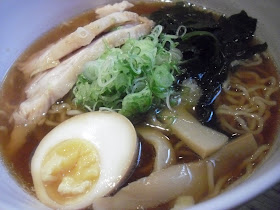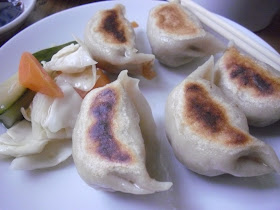The most popular post on this blog is, by a country mile, the
Dim Sum in London guide. However, a year has passed since I wrote it, so it's definitely time for an update. Whilst there isn't, in my opinion, a
definitive London dim sum restaurant, there are a number of places that I enjoy visiting. Having said that, it's important to keep up to date, so I've eaten dim sum at each of my recommendations on at least one occasion during the past year. It's a tough job, I know, but someone has to do it! So without further ado, here's my list of six of the best dim sum joints in London:
 |
| Wasabi prawn dumplings @ Phoenix Palace |
The One That's Like Being in Hong Kong
Joint 1st: Phoenix Palace - Full Review (October 2009)
Phoenix Palace's buzzy atmosphere brings the cliché -
it's just like being in Hong Kong - to life, which is why for a long time it was my favourite dim sum restaurant in London. Don't get me wrong, I still adore it, but nowadays it has to share the gold medal with Princess Garden.
Top Tips: check out the specials menu where delights such as
wasabi prawn dumplings and
baby octopus in chilli, lemon, and garlic sauce lurk. Classics such as
har gau (prawn dumplings) and
cha siu sou (BBQ pork puff pastry) are also top notch. And don't forget the excellent
Cantonese BBQ as epitomised by the must-order weekend lunch special of
roast suckling pig.
The Downside: service can be variable and there's the odd mediocre dish (the
siu mai and
xiao long bao are distinctly average). Prices have also crept up, and the dim sum here is easily the priciest of my recommendations, with individual dishes priced upwards of the £3 mark.
 |
| Baked cha siu bao @ Princess Garden |
The Classy One
Joint 1st: Princess Garden - Full Review (June 2011)
I'm still kicking myself that it took me so long to get round to sampling this elegant Mayfair restaurant. Whilst its dim sum is more expensive than many places, it's arguably better value given the higher standards of food and service. So much so, it has rapidly become my (joint) favourite dim sum venue in London.
Top Tips: check out dim sum that is rarely seen in London such as
golden cuttlefish cheung fun,
baked cha siu bao, and
paper-wrapped prawns with preserved egg. And for those of you with a sweet tooth, the
baked custard buns are a must.
The Downside: the Cantonese BBQ selection is limited to roast duck and that the porky delights of
cha siu (honey roast pork) and
siu yuk (crispy pork belly) are absent from the menu.
The One That's Like Being in Shanghai (Added March 2013)
?th: Bright Courtyard - Full Review (March 2013)
With a sister restaurant in Shanghai, Bright Courtyard offers a glimpse into where aspirational Chinese like to eat out. While the a la carte is more Shanghai, the dim sum is largely Cantonese. I'm not sure where to rank this restaurant, as I've only been once but there's a case for it to be up there at No.1.
Top Tips: As befits a Shanghainese restaurant, the
xiao long bao are top class, and the
scallop siu mai and
har gau are must orders.
The Downside: Some may baulk at the price although I think it's worth it. If anything, it's the slightly-muted, genteel atmosphere that detracts ever so slightly from the dining experience.
 |
| Fried chrysanthemum custard buns @ Pearl Liang |
The One With The Fancy Wallpaper
3rd: Pearl Liang - Full Review (May 2010)
Pearl Liang is widely recognised as one of London's top spots for dim sum. So why isn't it my number one choice? The thing is the atmosphere can sometimes be like the restaurant equivalent of the old 'Highbury library'. And whilst I was impressed by how inexpensive lunch was during my last visit (in mid-Nov) prices have increased since then.
Top Tips: leave room for dessert, as the
fried chrysanthemum custard buns and
black sesame balls are to die for. The classics are amongst the best in London, and I also like their
fried watercress meat dumplings.
The Downside: as I alluded to earlier, the ambience isn't all that it could be and don't get me started on the 'IKEA does Hakkasan' interior design.
 |
| Various dim sum @ Imperial China |
The Suburban One
4th: Imperial China - Full Review (September 2010)
The only thing you need to know about Imperial China is that Ma and Pa Noodles love it. They're better judges than most of us will ever be, so let's leave it at that! By the way, this Teddington restaurant is unrelated to the Chinatown restaurant of the same name.
Top Tips: stick to the classics, you won't go far wrong. Dishes like
har gau (prawn dumplings) and
cha siu bao (honey roast pork buns) are excellent. And despite being quite old school, there are a few interesting fusion-style dishes, with influences from Japan and Vietnam, that are worth checking out.
The Downside: Teddington is in Zone 6 and isn't exactly the easiest place to get to. Also be prepared to queue on Sundays unless you arrive early.
 |
| Village dumplings @ Dragon Palace |
The One With The Special Noodles
5th: Dragon Palace - Full Review (December 2010)
I still can't believe how Dragon Palace managed to stay under the radar for so long. This Earl's Court restaurant feels like it ought to be in Chinatown, except that it's too good for Gerrard Street.
Top Tips: Order the fish-filled
village dumplings and remember to ask about the
weekend specials. They also make their own
'silver-needle' noodles that are exceedingly rare in London. I'm also a big fan of the
pan-fried cheung fun, which is also rarely seen on these shores.
The Downside: whilst undeniably tasty, some of Dragon Palace's dim sum lack the finesse that the same dishes have at the restaurants ranked above it.
 |
| Fish balls & turnip @ Tai Tung |
The Old School One
6th: Tai Tung - Full Review (October 2011)
The Purley Way that skirts Croydon isn't where one might expect to find a restaurant serving decent dim sum. But Tai Tung (part of the
Wing Yip Centre) certainly fits that bill with its
old school charm.
Top Tips: All the old school classics are present and correct. Of particular note are the
scallop dumplings and the
fish balls & turnip.
The Downside: This isn't the place to try out the chef's specials or the latest dim sum from Hong Kong. And I never thought I'd say this, but it's a bit
too old school.
For those of you who might be a bit nervous ordering dim sum, don't be, as all of these restaurants have dim sum menus and order sheets (where applicable) in both English and Chinese. In the case of Tai Tung, the order sheet is in Chinese only but it can be referenced to a menu in English. In terms of prices, budget around
£15-£20/head (including tea and service) although light eaters can probably get away with spending
£10/head at Dragon Palace. Having said that, gluttons like me can quite easily order enough for the bill to creep up to
£25/head at Phoenix Palace.
This isn't an all-encompassing guide to London's dim sum scene; I don't have the capacity (quite literally) to check out the capital's myriad options. For instance, none of my choices are in Chinatown, and nor have I featured Michelin-starred places like
Hakkasan or
Yauatcha. The thing is I haven't found a Chinatown restaurant that I'd wholeheartedly recommend for dim sum, and in my opinion, there's something fundamentally wrong with the price-point and atmosphere of ultra-posh dim sum joints. However, if you'd like to get some further tips then check out my original
Dim Sum in London post, which has links to other bloggers' reviews of a wider range of restaurants.
PS: Do shout if you think there's a dim sum restaurant in London that should be on my radar.











































